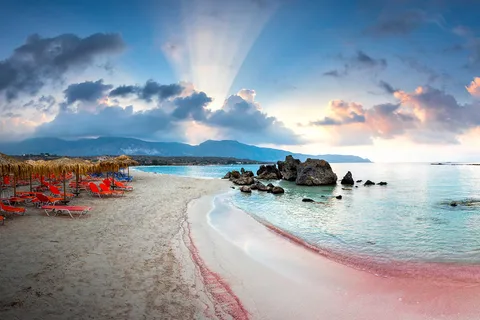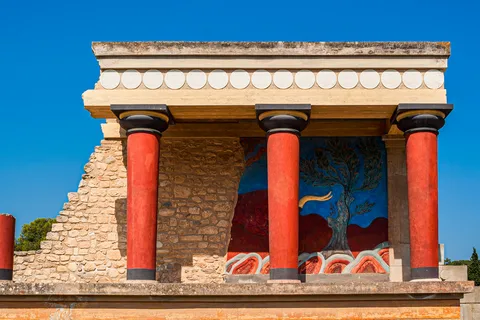
Continuing our occassional series of articles on Greek Islands we’re looking today at the largest and most Southerly of the islands of Greece, Crete. Click here for information of trips and visitor experiences in Crete or click the article images for specific attractions. For details of package holidays to Crete click here.
The History of Crete
Crete is the largest and most populous of the Greek islands. It boasts a rich and diverse history that spans millennia. Let’s take a journey through time:
- Prehistoric Crete:
- The story begins around the 7th millennium BC, preceding even the ancient Minoan civilization by over four millennia. Crete was inhabited during the Lower Paleolithic, with evidence of stone tools dating back to approximately 130,000 years ago.
- During the Neolithic period (around 9000 years BC), influences from the Cyclades and Egypt shaped Cretan culture. The mysterious script known as “Linear A” emerged during this time.
- The island’s first settlers introduced domesticated animals, cereals, and legumes.
- The Minoan Civilization:
- Crete became the cradle of Europe’s first advanced civilization—the Minoans—between 2700 and 1420 BC. Their palaces, intricate frescoes, and maritime prowess left an indelible mark.
- The Minoans traded with Egypt, the Cyclades, and beyond. Their capital, Knossos, housed the legendary labyrinth of King Minos and the myth of the Minotaur.
- The Minoan civilization eventually fell to the Mycenaean Greeks from the mainland.
- Subsequent Rulers:
- Crete’s history continued to unfold under various rulers:
- Roman Rule: In 67 BC, Rome annexed Crete, integrating it into the Roman Empire.
- Byzantine Era: After Rome, Byzantium took the reins.
- Venetian Influence: In 1204, Crusaders sold the island to Venice, which held sway until the Ottoman Turks conquered Crete in 1669 after a protracted siege.
- Ottoman Empire: Crete remained under Ottoman rule until the late 19th century.
- Crete’s history continued to unfold under various rulers:
Geography
Crete is known for its diverse topography, from sandy beaches to rugged mountains. The island is divided into four main regions: Chania, Rethymno, Heraklion, and Lassithi. Each region has its own unique charm:
- Western Crete (Chania): Known for the scenic Samaria Gorge, picturesque Venetian harbors, and stunning beaches like Elafonissi and Balos Lagoon.
- Central Crete (Heraklion): Features the bustling capital of Heraklion and important historical sites such as the Palace of Knossos, an archaeological treasure.
- Eastern Crete (Lassithi): Quieter and less touristy, known for the Vai Palm Forest Beach, and the secluded island of Spinalonga.
- Southern Crete: This area is more rugged and less developed, with peaceful villages, hidden beaches, and historical monasteries.
Historical & Cultural Sites
Crete’s history spans millennia, offering a wealth of ancient ruins, medieval fortresses, and traditional villages:
- Knossos Palace: The most famous Minoan archaeological site, located near Heraklion. This ancient palace dates back over 4,000 years and is linked to the myth of the Minotaur and the Labyrinth.
- Heraklion Archaeological Museum: One of Greece’s top museums, featuring Minoan artifacts, including frescos, sculptures, and pottery.
- Venetian Harbor of Chania: A beautiful old town with a charming harbor, narrow streets, and a lighthouse built during Venetian rule.
Must Visit Places in Crete
Now that we’ve explored its history, let’s uncover some of Crete’s captivating destinations:
- Elafonissi Beach:
- Known for its pink sand and crystal-clear waters, Elafonissi is a paradise for beach lovers. It’s located on the southwestern coast and offers stunning natural beauty. For details of trips to Elafonissi and other Cretan beaches click the image.
2. Balos Lagoon:
- Balos, accessible by boat or a scenic hike, features turquoise waters, a dramatic rocky landscape, and a Venetian castle. It’s a photographer’s dream.
3. Samaria Gorge:
- Hike through this breathtaking gorge, Europe’s longest, surrounded by towering cliffs. The rugged terrain and pristine wilderness make it an unforgettable experience.
4. Knossos Palace: Explore the ancient Minoan palace of Knossos, where myths intertwine with history. The reconstructed frescoes and labyrinth legends await your discovery. Click the image for details of trips to Knossos Palace.
5. Spinalonga Island:
- Once a quarantine island, Spinalonga is now a hauntingly beautiful place. Wander its paths, visit the Venetian fortress, and learn about its poignant history.
6. Chania Old Town:
- Stroll through narrow alleys, admire Venetian and Ottoman architecture, and savor local cuisine in this charming harbor town.
7. Ierapetra Archaeological Museum:
- Marvel at marble artifacts and delve into the island’s past. The museum provides insights into Minoan, Roman, and Byzantine Crete.
Crete isn’t just a place, it’s a living tapestry of civilizations, landscapes, and stories waiting to be explored. Whether you’re a history enthusiast, a beach lover, or an adventurer, this island has something magical to offer.
Beaches
Crete boasts some of the best beaches in Greece, suitable for all types of travelers:
- Elafonissi Beach: Famous for its pink sand and shallow, crystal-clear waters, located in the southwestern part of Crete.
- Balos Lagoon: A breathtaking turquoise lagoon in the northwest, accessible by boat or a hike.
- Vai Beach: Known for its palm forest and golden sand, on the eastern coast.
- Matala Beach: Popular for its unique caves and a relaxed, bohemian vibe, it was a famous hippie destination in the 1960s and 70s.
Outdoor Activities
Crete is perfect for adventure enthusiasts, offering a range of activities such as:
- Hiking: The Samaria Gorge is the most famous hike, a 16 km trek through dramatic cliffs and wild landscapes. Other popular gorges include Imbros Gorge and Aradena Gorge.
- Snorkeling & Diving: The island’s clear waters are ideal for underwater exploration, especially around Chania and Agios Nikolaos.
- Water Sports: Windsurfing, kite surfing, and paddleboarding are common on Crete’s beaches.
- Exploring Caves: Dikteon Cave, believed to be the birthplace of Zeus, and Melidoni Cave are must-see spots for cave lovers.
Getting Around
- Car Rental: The most convenient way to explore Crete’s diverse landscapes and hidden spots. Roads are generally good, though some remote areas may require a 4×4 vehicle.
- Buses: An affordable option for getting between major cities and tourist spots. KTEL operates the main bus network on the island.
- Ferries: Regular ferry connections to Crete from Athens (Piraeus), and between Crete and nearby islands like Santorini and Rhodes.
When to Visit Crete
Choosing the right time to explore this Greek island can make all the difference.
- Summer (July and August):
- High Season: If you’re all about non stop parties, endless festivals, and rubbing shoulders with fellow travellers, then summer is your time. Everything is open, and the island buzzes with energy. Average highs hover around 29°C (84°F), and the beaches beckon.
- Tip: Book your flights and accommodations well in advance—those beachfront spots fill up faster than a plate of moussaka at a family gathering!
- Shoulder Season (April to June, September, and October):
- Moderate Crowds, Mild Weather: This is my personal favorite. Most businesses and attractions are open, but the crowds are more manageable. Imagine renting a beach umbrella, savouring a seaside taverna lunch, and exploring remote mountain churches—all without the frenzy. Average daytime highs range from 20°C to 27°C (68°F to 80°F).
- Bonus: You might even snag some last-minute deals. Rain? Rare. Sun? Abundant.
- Low Season (November to March):
- Beaches to Yourself: Okay, so during these months, it’s like Crete whispers, “Psst, come have me all to yourself.” Tourist focused places hibernate, but if you’re an intrepid explorer, you’ll find rooms for rent in larger towns and cities. Plus, the world class ruins at Knossos remain open year round.
- Weather: Expect average temps around 15°C (59°F), and yes, there might be some dramatic storms off the Med. But hey, deserted beaches and bracing walks.
- Fun Fact: January is museum and church time. Cretans celebrate New Year’s Day with golden glazed cake and bless the waters on January 6th.
With so much to explore and experience, whenever you choose to visit, Crete never disappoints.
Join our mailing list.








